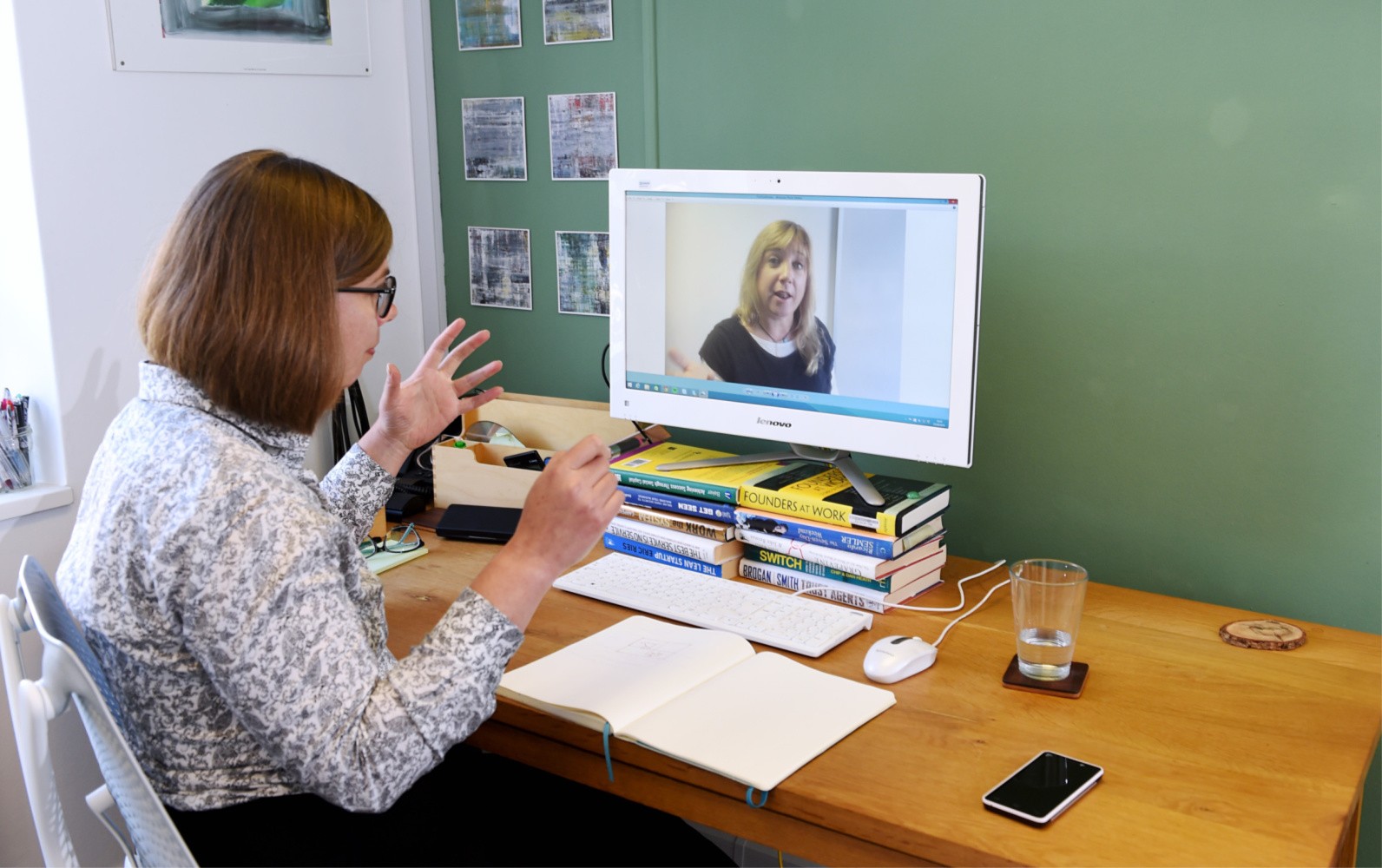Using Zoom to make your business better

We’re all using Zoom now, right? This article is full of ideas to use Zoom to make your business better. We’re going far beyond the obvious making calls, having client meetings over Zoom and joining meet-ups and webinars.
Here are some ideas to use Zoom to improve your business. The first part is for you if you have a team of people working together. Scroll down if it’s just you, or you and your partner and the cat.
Using Zoom for better team meetings
If you have a team or a group of associates you work with, you’ll probably already be getting everyone together for a Zoom team meeting. Organisations who have been doing remote working for a long time have found that getting together every week is vital to keep the feeling of being a team. But you want to have a clear way of organising that meeting; otherwise, it turns out to be just a bunch of people chatting and waving at one another. Here are some suggestions to make team meetings work well on Zoom.
If your team meeting is at 10 am, tell people that you’ll be on the call from 9.45 am for chat and hellos. Then you can spend 15 minutes asking Sheena how the sales meeting went the other day or talking to Rob about his poorly dog – the usual chit chat you’d have in the office when you’re all making a coffee for the team meeting.
The 15-minute chat bit means you can start the team meeting promptly at 10 am, rather than waiting for laggards to switch their video on. Not everyone has to join the 9.45 bit. In fact, after the first couple of meetings, you don’t have to either. You can get someone else to do the chatting while you make your coffee or check your email.
Once your team meeting has started, have a list of what you want to cover. It helps to give everyone this list beforehand. Then they know that they’ll need to have the KPI report open. Encourage people to share screens and to stop sharing when they’ve finished talking so someone else can take over and you’re all looking at one another as much as possible.
Huddles
Companies have historically been reluctant to let staff work remotely because they fear losing the “water cooler conversations” which pop up naturally when you’re in the office together. In the UK, this tends to be the kettle rather than the water cooler, but you know the spontaneous conversation I mean.
There are a couple of ways of recreating this more spontaneous way of getting together, without losing the staff time and productivity that you would in an office situation.
One of my client’s companies decided in the first weeks of Coronavirus isolation that they would give up the lease on their expensive London office and go virtual. They were already doing weekly “resource planning” meetings with a clear agenda, so they transferred these to the same time at 9.30 am on Thursdays. I suggested that they do a “close of business huddle” for 10 minutes every day.
For some companies, the 10-minute meeting agenda works well – see this article for a suggested format. My client, already had this covered in their “resource planning” meetings, and they wanted something more informal. Instead, they met up at the end of the working day, with most of the team there. It wasn’t obligatory to attend as some staff have children and can’t work conventional hours anymore.
In that 10 minute huddle they asked a different couple of staff members each day two questions.
“What was the best thing at work today?”
And
“What new thing did you learn today?”
I’m told these are the questions Barack Obama asks his kids each night. I’ve asked these questions of my partner over dinner, so do try them out in other situations too. You get some great answers.
Quick chats on Slack
If you find yourself having lots of Instant Message type conversations on Slack, you know… when both of you are typing at once, install the Zoom add-on to Slack, and you can call that person from within Slack. Make sure everyone knows that you’ve added this, in case your colleague is working in the garden. In my case, when I have my hair tied up in an unflattering ponytail or I’m eating lunch, and I’m not set for professional-looking video calls, I don’t switch the video on.
Tips on using Zoom for marketing webinars
To offer a high-quality webinar or online workshop, you have to come up with something that answers one of your customer’s problems. It has to tick the “what’s in it for me” box for them for it to be worth their time and attention. Otherwise, they’ll ignore your invitation, sign up and not attend. Or come along, zone out or leave the meeting.
Work out what your customer’s needs are likely to be right now. And how you can answer one or two of them. Ideally, this is very specific where you have some proven expertise in and no one else is filling this need or answering this problem. That’s a great way to get people to sign up to your webinar.
Some good examples might be:
- A demonstration of how to write a compelling social media message or Facebook ad (if you do social media services for businesses)
- How to use your new sewing machine to make one of my downloadable dress patterns (might be coming soon from MIY Collection
If your online workshop or webinar is going to be less than 100 people, and you’re not intending to reuse the content except for publishing the replay, Zoom is an excellent tool. And you’ve probably gone through 80% of the learning curve for using it.
It’s what I use for my workshops, as I don’t particularly want to have to learn new webinar software right now. Here are some tips on how to use Zoom for conference calls and online workshops which takes you through the other 20% of the learning curve. Remember that if your webinar is going to be more than 40 minutes, you’ll need a paid Zoom plan, which is $14.99 per month. B
If you have a much bigger potential audience, you might not want to use Zoom. For people who want to seriously use webinars and online workshops as part of their marketing mix, Zoom might not be your best option. Shane Melaugh has a round-up of the best webinar software here and recommends WebinarJam as the best fancy pants option. But bear in mind that Webinarjam has a $499 price tag and a learning curve.
That’s a quick guide to running webinars on Zoom, but let’s get on to the exciting and less obvious ways to use Zoom to boost your business.
Discovery sessions on Zoom

I’m a big fan of the paid discovery session, and I’ve got quite a few clients using them. And there’s no reason why you can’t do these on Zoom.
A paid discovery session is where when someone gets in touch to buy your services. Instead of setting up a sales meeting, you offer them a discovery session. You spend a good chunk of time with them workshopping what their problem is and coming up with options for solving this problem.
For example, when I needed a new website a few years ago, I paid a web development company £750 for two one-to-one workshops. We went over exactly what I wanted from the new site, the options for different technologies to achieve my aims, and got lots of tips on what I could expect the site to do.
There were a few learning points from my experience as a customer here. By the end of it, I trusted this company and wanted them to do my website. I wasn’t going to go anywhere else.
This was good for them, but unfortunate for me, as it turned out that they were great at sales, but not so great at making e-commerce membership sites. And although I’d gone in there with a budget of 3-5k, after the workshops, I was happy to spend 6-8k.
These discovery session workshops were face to face. But if you’re not able to do this because your clients are not in your local area, you can adapt this quickly to doing discovery sessions on Zoom.
Adaptations for doing paid discovery sessions on Zoom
- We can’t maintain attention for such a long time on Zoom. You’ll need to split the time up into chunks of no more than two hours. I’d recommend 90 minutes as a maximum.
- Think about doing a detailed questionnaire beforehand so you have a lot of the information you’ll need from the client before the meeting. One of my clients used to do this for all of his new clients, with a beautifully formatted well thought out document – you could do an online version of this. Be careful with how much information you ask for at this stage, you might need to be sensitive with how you ask about confidential or financial information
- Think about having some slides pre-made so you can demonstrate critical points easily, especially if you’re like me and like to draw explanations and models for prospective clients.
If discovery sessions aren’t right for you, maybe you can do free consultations on Zoom
Discovery sessions aren’t right for everyone; in fact, I don’t do them myself as my work relies on helping clients to make changes over time in my business coaching and programmes, rather than solving a problem right there and then. But you can still use Zoom to do a free consultation as part of your sales process.
I call my version of this a “coffee and cake” session from the days when I used to do most of my work face to face. For the past couple of years, I’ve had to provide my own coffee because the meetings are online. And I don’t always eat cake over Zoom.
Maybe you’ve already set up your marketing to steer people towards picking up the phone to contact you. You can change this quickly to offer people the chance to pick a time to meet up with you on Zoom. Add a calendar to your website which shows your availability for initial consultations and lets people book in there and then. You then get the advantage of being open for bookings 24 hours a day. And get more bookings from people who are likely to schedule something online than make an initial call. You can use You Can Book Me or Calendly for this. Both are pretty easy to set up.
Don’t just stop with the free consultation part
Steering people to a free consultation on Zoom can be the first step towards moving your business to an entirely virtual organisation. Maybe this is only for however long we have to do this physical distancing dance, or it’s something you want to do anyway.
Some companies are thinking that they might give up their office space to cut costs. And solo entrepreneurs who have historically met clients in hotel lobbies or rented meeting rooms because they work from home are embracing that feeling that Zoom meetings are the new normal. It saves pretending that you have a “proper” office or having to spend the time travelling to the client’s premises.
Then you start thinking about other bright things you can do with your online marketing. Maybe you can encourage potential clients to download your lead magnet, so they receive something valuable from you. And you have permission to start wooing them with email marketing.
Before you know it, you’ve entirely re-engineered your sales funnel and your business process and developed a whole new channel to market, with some lovely new clients.
Oh, I’ve already got all that Julia, tell me about the clever stuff you can do with Zoom.
Okay, here’s the clever stuff.
Sell a mini project on Zoom
Sometimes clients don’t need a discovery session or a free consultation. Or they’ve had one of these, but they’re not quite ready to commit to the big project you’d like them to engage you for. You need a mini project to start working with them. Something that will begin to solve their problems, give them a demonstrable quick win, and build their trust in you.
Here are some examples:
- Web design agencies might pick one of the key elements from the discovery session such as keyword analysis or creating a brand guide to do as a stand-alone mini project
- Forward-thinking accountants who want more clients might do a cash flow plan for a fixed fee. Potential clients might never have had this from their old accountants and be so impressed that they want to change all their services
- Content writers might come up with a content calendar full of ideas. Give this to your client as a one-off mini-project. Of course, the client finds that they don’t have the time to create all the content for these ideas. Who are they going to call to make this happen?
What could your mini project product be?
And while we’re talking about products…
Using Zoom to help you pivot your business
Let’s flip your business challenges around by pivoting to something a little different. And make that new offering better than what you had before.
You’ve got used to being on Zoom for client meetings, and you’ve got your home office sorted out now. Don’t forget that ergonomic chair – you might be sat there for a while.
Here are some ideas for changing your business now everyone’s getting used to being on Zoom as our primary form of communication.
The obvious one – create an online course

You can take all the lovely expertise you’ve built up in your area and turn it into an online course. And then sell that to your existing target market. Or sell it to larger companies who are doing staff training with their furloughed staff.
Why not do a quick and dirty version of your online course to test it out? Just do live learning sessions on Zoom. Then present it to a big company and suggest that they pay you to do a better version and put it on a mobile learning management system. Then you can sell a slightly different version to another company and make twice the money for minimal extra effort.
Or sell your online course to your competitors. Sounds mad? It’s a good option if you have particular skills in one area that your competitors don’t. Even if they do your course and you give away all your secrets, they still won’t be as good at that skill as you because they haven’t had the same time for deliberate practice, so you maintain your primary competitive advantage. And you have a beautiful new income stream.
Zoom isn’t the best tool for recording the videos for an online course – if you’re going into this as a permanent pivot, you’d be much better off learning how to use Camtasia. But for a quick start, recording yourself on Zoom builds on those skills you’ve learned from the video calls, and it’s good enough quality for most people.
Integrated learning programmes
The online course market is getting a little crowded, and there are only so many learning videos people can watch after a while. You might want to think about doing this one slightly differently as well, and instead of doing stand-alone online courses, make some integrated learning programmes.
The great thing about this kind of integrated learning programme is that you don’t have to do so much work before you launch and you can get it out there much faster. Most people who decide to do a pre-recorded video course fail because they don’t finish making the product. Setting up integrated learning programmes takes more time in the end, but they can be much faster to get to market. And you can charge more money because it has your time included in it, so customers perceive it to be worth more.
How to make your online courses stand out
Can you be the new Netflix on Zoom?
This one isn’t for everyone, but there’s something to be said for carving out a little piece of the Netflix/YouTube explosion. Everyone is watching something online now we can’t go to the pub or the cinema.
Quick tip – not business-related
By using the share screen facility on Zoom, you can watch a film online with family and friends when you can’t be physically present. It only works with people you know well enough not to have to talk to all the time, but it’s a lovely cosy way to spend the evening.
Back to business pivots
Is there something you could give a talk on Zoom about? Your area of interest and in-depth knowledge? Maybe you’re an architect and you know tons about Victorian buildings. Or you recorded your time in a Palestinian refugee camp, and you want to tell the world what it’s like.
You could set up a Zoom meeting, prepare your talk and tell people it’s happening. Charge a small fee to come along and do your presentation on Zoom.
It’s isn’t likely to make enough for you to pay your rent and eat. It’s more of a temporary stop-gap, but it does get you into the idea of doing paid talks and developing some different online marketing techniques.
It helps you build your audience and try out some experiments. It might lead to you building online communities and other products along the way. What’s stopping you trying something new? And, of course, this process builds up marketing assets for the future.
Here are some examples of this to play with:
- Business book discussion evening – I’ll come along to this
- Knitting techniques show and tell
- Guided local walks on Zoom for hotels to give to all the customers. This would help your guests to be very keen to rebook.
- DIY tips in your local area from a handyman (not sure of the gender-neutral equivalent of this, sorry). Note, Facebook Live might be better for this than Zoom
- Travel tales from someone who has been to lots of exciting places. Record your narration, and maybe this becomes a video product with a bit of editing. Or the start of that book you always meant to write
Areas to consider for pivoting to online
Can you set up new systems for onboarding clients? What about a Zoom call when a new client starts or recording a welcome message from yourself on Zoom to send out in an automatic email? Are there frequently asked questions you get from 80% of clients which you could record in a screen share video or an explainer video you record on Zoom? If this saved you an hour per client, that could add up significantly over time, and provide a better experience for customers.
Better customer experience to encourage client retention?
Again, recording yourself on Zoom, maybe with screen share or with you demonstrating how to use your product could save you time and make customers remember you. That gives you a competitive advantage. And these videos don’t have to be brilliant quality in the same way that a marketing video would – there’s not the same level of expectation at this stage.
Could you change 80% of your business to virtual working? Or 100%? Start noticing what works on Zoom, and how you could replicate this in the future.
And (the big one) can you change your business model at this point?
Start challenging yourself on how you operate your business. Are there ways you can change what you do to encourage clients to buy from you on a recurring income business model? Or productise your services so it can be more efficiently delivered online and can make more money for you?
Let me know what your thoughts are and how you can apply these ideas in your business


